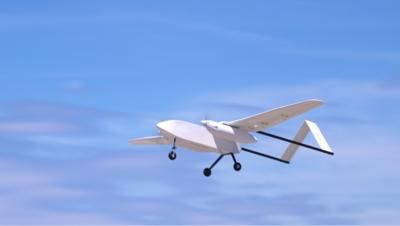Fri, Nov 25, 2022
Self-Contained Hydrogen Engine Nacelle May Be Offered as UAV Aftermarket Modification
H3 Dynamics' twin-engine hydrogen UAV demonstrator completed its first successful test flight over a Paris airfield.

The flight was a capstone of sorts, for a program that first completed a working propulsion nacelle prototype a year prior. By July, H3 Dynamics had been able to test their first distributed pod system on a scale aircraft at the Hub Drones - Systematic airfield near Paris, France. That proved the basic functionality of their hydrogen-powered system, allowing them to begin scaling up their designs. The most recent test evaluated the performance of a twin-engine, hydrogen powered, propeller-driven propulsion aircraft on the way towards larger, more complex installations. While H3 Dynamics will need to continue their progress flying small, uncrewed aircraft, the company eagerly looks to the future, with plans for bigger and better hydrogen aircraft converted from existing makes and models. With the successful demonstration of a twin-engine platform, the company says it will soon tackle a 6-engine aircraft in the same vein.
The uncrewed twin-engine test aircraft boasts a 900 km range on liquid hydrogen, stored entirely in its wing-mounted nacelles. That external mounting allows for safer, less anxiety-inducing carriage of super-flammable hydrogen fuel in addition to maximizing interior cargo storage. Should the demonstrator be powered with pressurized hydrogen, its range drops to 350 km, still quite passable given the aircraft's 30-liter interior volume. H3 Dynamics sees their standalone hydrogen nacelle design as a perfect candidate for aftermarket installation and retrofitment, an easy way to bolster the power of any small aircraft with sustainable, on-demand thrust. The compact size should mean the self-contained hydrogen nacelles can quickly be developed into a snap-on addition to existing eVTOL or fixed wing cargo drones.
“Not only is safety our first priority, but we don’t want hydrogen competing for revenue-generating air freight and passenger space,” said Taras Wankewycz, CEO of H3 Dynamics. As outlined by the company's hydrogen developers, distribution of hydrogen power is key. Spreading the hydrogen propulsion systems allows for more efficient thermal management, increased redundancy, and simpler installation.
H3 Dynamics made mention of their plan to complete an Atlantic crossing on hydrogen-electric hybrid propulsion in the next 2 years, proving the feasibility of liquid h2 power with partner ISAE-SUPAERO.
More News
Cooperative Surveillance Any surveillance system, such as secondary surveillance radar (SSR), wide-area multilateration (WAM), or ADS-B, that is dependent upon the presence of cert>[...]
Aero Linx: OX5 Aviation Pioneers Incorporated in 1955 as a Pa 501 (c)(3) Not for Profit Corporation, the OX5 Aviation Pioneers is dedicated to bringing before the public the accomp>[...]
The Pilot Appeared To Regain Control After Six Rotations And Attempted To “Fly Out” Inverted But Had Insufficient Altitude On November 8, 2025, at 1038 eastern standard>[...]
From 2018 (YouTube Edition): Aero-News Talks With The Airplane's Builder One of the many unique airplanes at AirVenture 2018 was a 1/3-scale B-17 bomber built by Jack Bally, who ta>[...]
Aero Linx: Society of U.S. Army Flight Surgeons (SoUSAFS) The Society of US Army Flight Surgeons (SoUSAFS) serves to advance the science and art of Aerospace Medicine and its allie>[...]
 ANN's Daily Aero-Term (12.04.25): Cooperative Surveillance
ANN's Daily Aero-Term (12.04.25): Cooperative Surveillance ANN's Daily Aero-Linx (12.04.25)
ANN's Daily Aero-Linx (12.04.25) NTSB Prelim: Extra Flugzeugproduktions EA 300/SC
NTSB Prelim: Extra Flugzeugproduktions EA 300/SC Classic Aero-TV: The Bally Bomber - The All Time Ultimate Warbird Replica?
Classic Aero-TV: The Bally Bomber - The All Time Ultimate Warbird Replica? ANN's Daily Aero-Linx (12.05.25)
ANN's Daily Aero-Linx (12.05.25)



